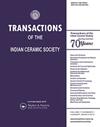MgAl2O4:M(M=Ti,Mn,Co,Ni)荧光粉的光致发光性能:煅烧行为和光致发光机理
IF 1.5
4区 材料科学
Q3 MATERIALS SCIENCE, CERAMICS
引用次数: 8
摘要
摘要采用改进的聚丙烯酰胺凝胶法制备了MgAl2O4:M(M=Ti,Mn,Co,Ni)荧光粉。煅烧温度和金属颗粒对Mg-Al2O4:M荧光粉的相变、光学性能和显色性能有显著影响。引入MgAl2O4系统的Ti、Mn、Co和Ni金属颗粒可以产生从白色、灰黑色、蓝色到绿松石蓝色的各种颜色。在MgAl2O4体系中加入Mn、Co和Ni金属颗粒可以将其光吸收扩展到可见光范围,而包覆在体系中的Ti金属颗粒没有显著改善。加入到MgAl2O4体系中的Co金属颗粒可引起395nm处发射峰的荧光猝灭和405nm处发射峰值的增强,而加入到体系中的Ti和Mn金属颗粒可使425nm处的可见光发射峰值增强。395nm处的峰值的荧光猝灭可归因于与MgAl2O4:M磷光体的表面等离子体吸收带匹配的Co金属颗粒的波长。425nm处发射强度的降低可以归因于从MgAl2O4的导带(CB)到金属颗粒的CB的电子转移,从而引起非辐射衰变。图形摘要本文章由计算机程序翻译,如有差异,请以英文原文为准。
Optical and Photoluminescence Properties of the MgAl2O4:M (M = Ti, Mn, Co, Ni) Phosphors: Calcination Behavior and Photoluminescence Mechanism
Abstract MgAl2O4:M (M = Ti, Mn, Co, Ni) phosphors were successfully prepared by a modified polyacrylamide gel method. Calcination temperature and metal particle has significant effects on the phase transition, optical and color properties of Mg Al2O4: M phosphors. Ti, M n, Co and Ni metal particles introduced into the MgAl2O4 system can produce a variety of colours from white, grayish black, blue to turquoise blue. Mn, Co and Ni metal particles added into MgAl2O4 system can extend their light absorption to visible light range, while the Ti metal particles clad into the system did not improve significantly. Co metal particles appended into the MgAl2O4 system can cause fluorescence quenching of emission peak at 395 nm and enhancement of emission peak at 405 nm, while the Ti and Mn metal particles infused into the system can bring the enhancement of visible emission peak at 425 nm. The fluorescence quenching of the peak at 395 nm can be ascribed to the wavelength of Co metal particles matching the surface plasmon absorbance band of MgAl2O4:M phosphor. A reduction in emission intensity at 425 nm can be assigned to electron transfer from the conduction band (CB) of MgAl2O4 to the CB of metal particles causing non-radiative decay. GRAPHICAL ABSTRACT
求助全文
通过发布文献求助,成功后即可免费获取论文全文。
去求助
来源期刊

Transactions of the Indian Ceramic Society
工程技术-材料科学:硅酸盐
CiteScore
2.40
自引率
8.30%
发文量
12
审稿时长
2.3 months
期刊介绍:
Transactions of the Indian Ceramic Society is a quarterly Journal devoted to current scientific research, technology and industry-related news on glass and ceramics. The Journal covers subjects such as the chemical, mechanical, optical, electronic and spectroscopic properties of glass and ceramics, and characterization of materials belonging to this family.
The Editor invites original research papers, topical reviews, opinions and achievements, as well as industry profiles for publication. The contributions should be accompanied by abstracts, keywords and other details, as outlined in the Instructions for Authors section. News, views and other comments on activities of specific industries and organizations, and also analyses of industrial scenarios are also welcome.
 求助内容:
求助内容: 应助结果提醒方式:
应助结果提醒方式:


